Oxalis spp.
My first shamrock was more than a houseplant. It was a link to my Irish grandma and the folks in County Cork I’d never known – or so I thought.
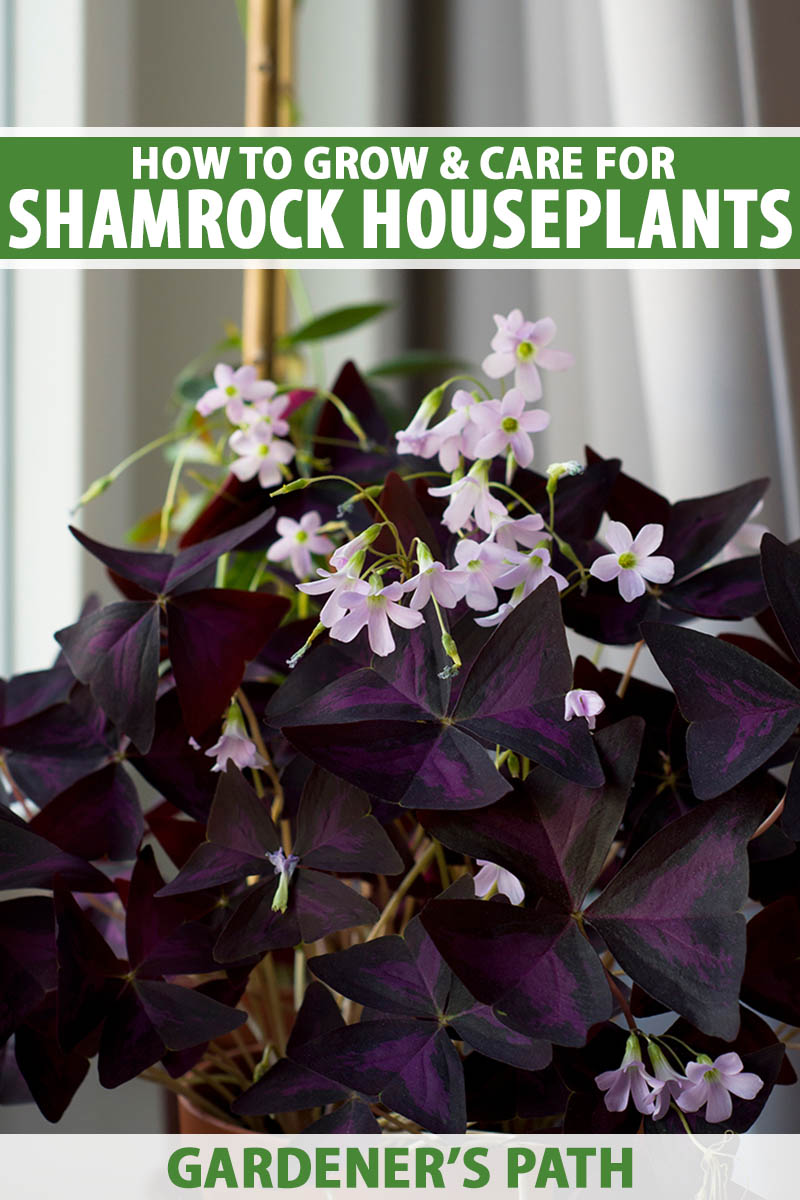
We link to vendors to help you find relevant products. If you buy from one of our links, we may earn a commission.
I later learned that there is nothing Irish about a shamrock plant, but the flowers and foliage are pretty and Oxalis are long-lived species.
Join me to discuss the shamrock plant and how to grow and care for your own houseplant.
Here’s what we’ll cover:
What You’ll Learn
Let’s start with some background.
Cultivation and History
The word shamrock is Irish for “little clover,” and clover species belong to the Fabaceae or pea family.
They have three-lobed leaflets – unless you genuinely have the luck o’ the Irish and find one with four. Saint Patrick is said to have used a type of clover leaf to explain the Holy Trinity, elevating the tiny leaf to a position of honor.
He might have used white clover, Trifolium repens, a species with white flowers that often grows in our lawns.
Or perhaps lesser trefoil, T. dubium, a three-leafed species with yellow blossoms.
There is debate about which of the clovers is the “true” Irish shamrock. White clover is plentiful, growing as feed for grazing animals. There’s not much magic in that.
But the lesser trefoil is a perky little wildflower whose ubiquitous presence is as beloved as the leprechaun. It’s no wonder many accept it as the true shamrock.
However, these clover species are not showy and don’t do well as houseplants.
Our subject shamrocks are neither white clover nor lesser trefoil. They are not any type of Trifolium species, nor are they in the pea family.
They are imposters.
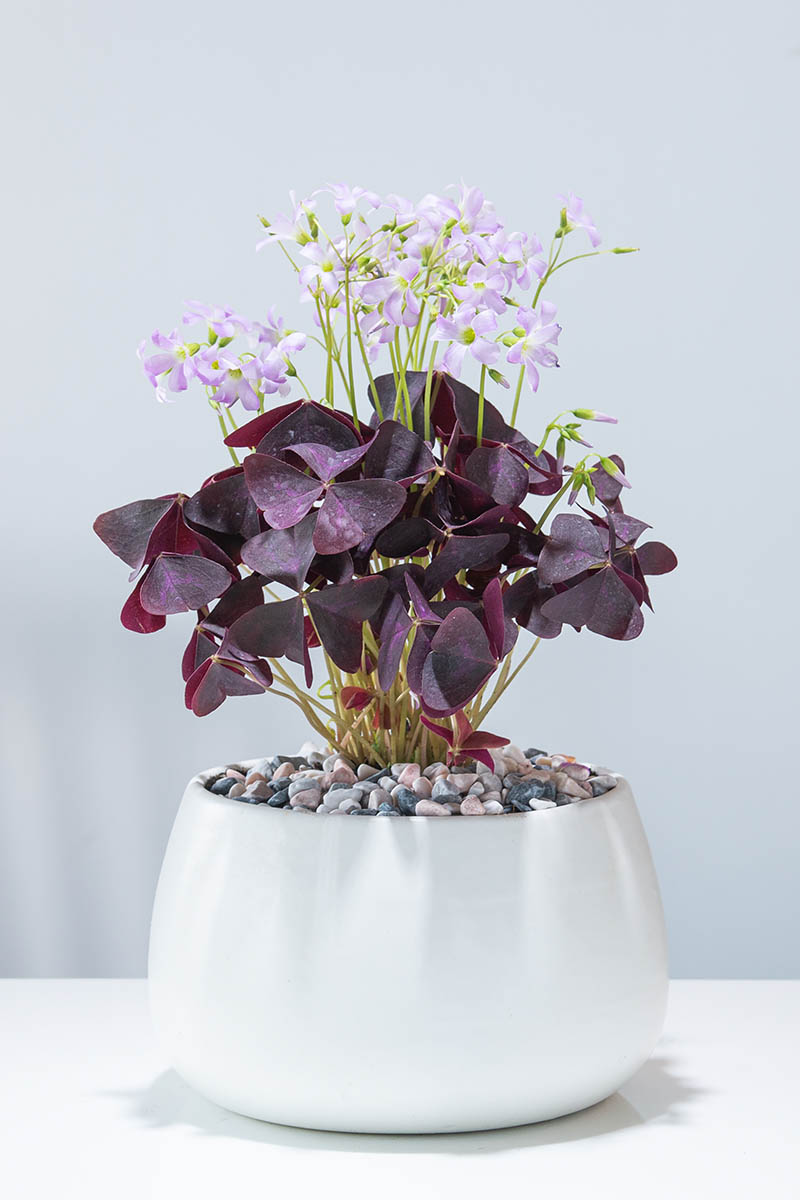
The shamrock plants we buy around St. Patty’s Day with the green, purple, or variegated foliage are several types of Oxalis, from the Oxalidaceae or wood sorrel family.
A closer look reveals a less rounded, more angular, or heart-shaped leaf larger than ground clover.
You may already recognize a common wild Oxalis that looks like clover and has a yellow flower and green or purple leaves. It pops up in the lawn, flowerpots, and cracks in the sidewalk.
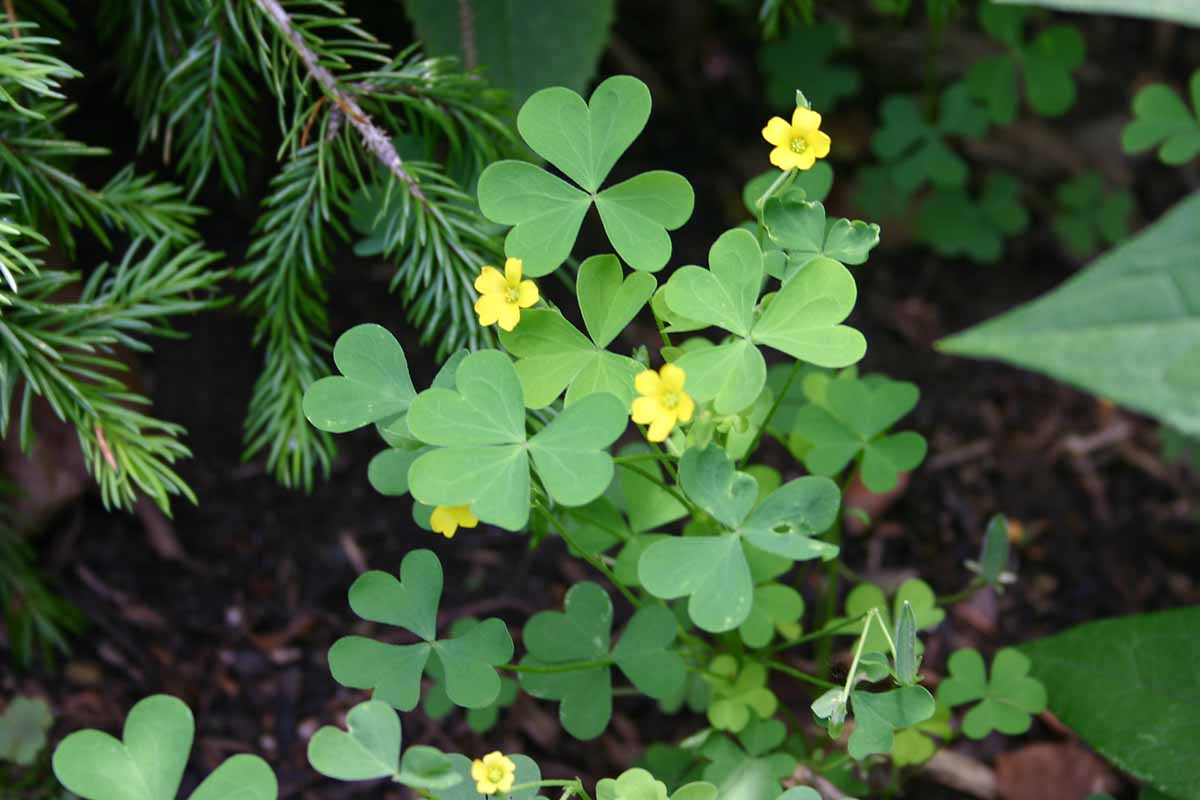
There is a native species with this description, O. stricta, and a non-native creeping species, O. corniculata. Both are potentially invasive.
Indigenous Americans have long used the native species to treat ailments like sore throats and dyspepsia, despite an oxalic acid content in these plants that may be toxic in large quantities.
The Greek name Oxalis means acidic or sour.
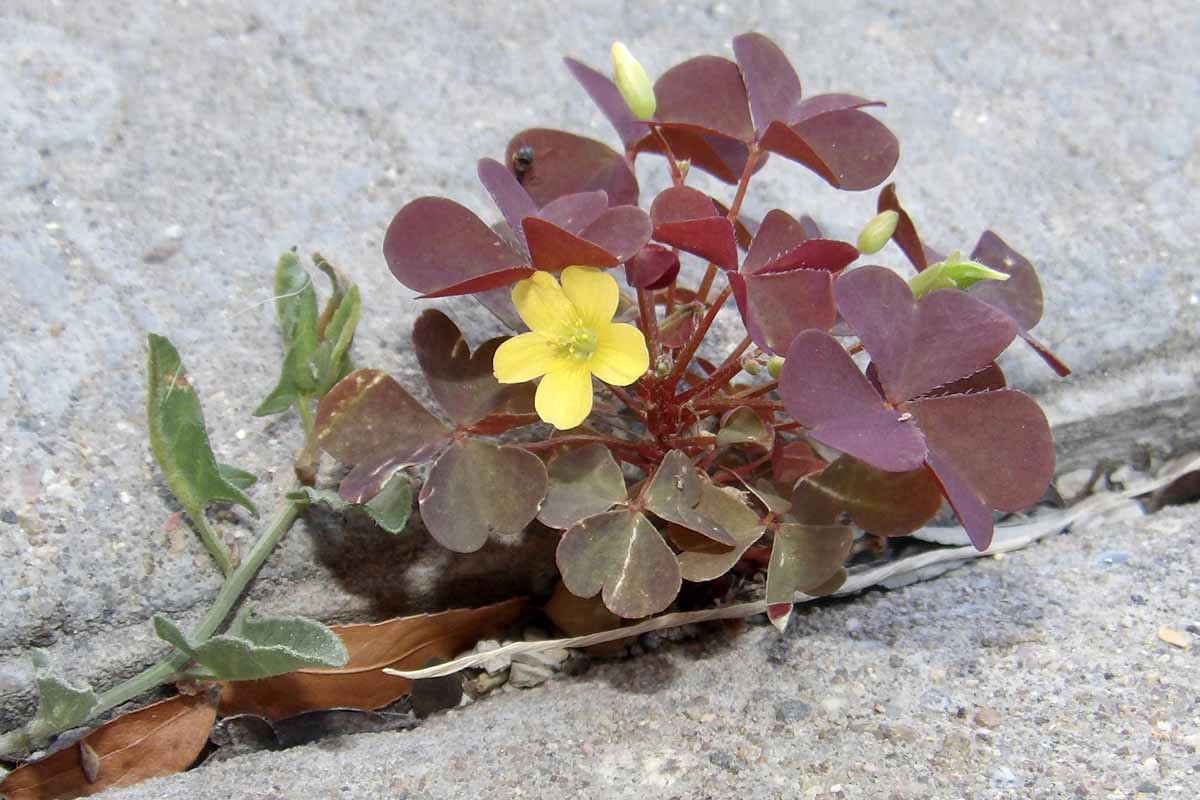
Other wild Oxalis species with aggressive tendencies include Bermuda buttercup, O. pes-caprae, and pink wood sorrel, O. articulata.
Another non-native yellow-flowering Oxalis you may be familiar with is oca, O. tuberosa.

The edible roots are large and have long been a cultivated food crop in the Andes and New Zealand.
A Note of Caution:
Keep children and pets away from all Oxalis species, including shamrocks, to avoid ingestion and possible oxalic acid poisoning.
To add insult to injury, Oxalis is not native to Ireland. Instead, the species in this large genus come mostly from Africa and Central and South America.
As mentioned, there are also North American species. And one of the more recently described species, O. simplicifolia, was found in French Polynesia.

The first shamrock hit the St. Patty’s Day market in the United States in the 1980s. It was a purple-leafed O. triangularis from Brazil.
The shamrocks we find for sale around St. Patrick’s Day are Oxalis of various species, including the green-leafed O. regnellii, plum and purple O. triangularis (aka O. regnellii var. triangularis), and green and purple four-leafed O. tetraphylla (aka O. deppei).
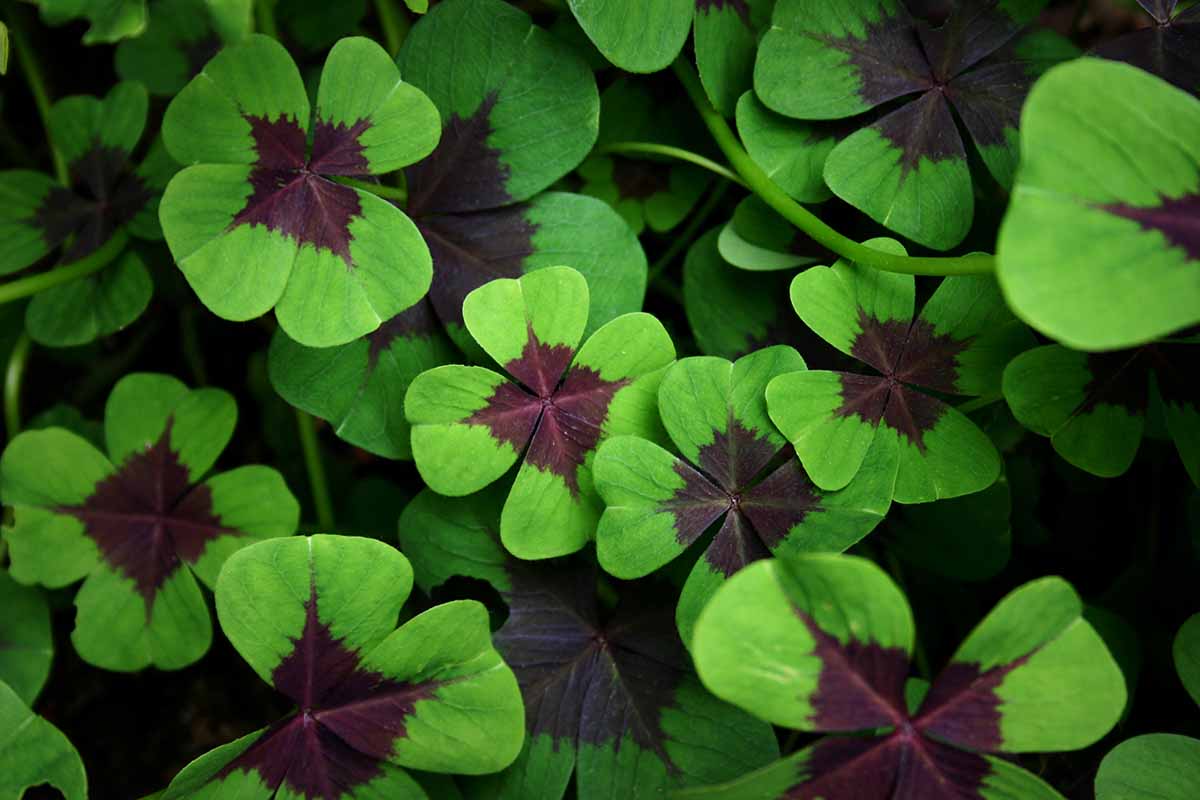
Oxalis flowers may be pink, red, white, or yellow. They bloom in clusters from spring to summer.
Plants grow from bulb-like tubers called rhizomes. They are active in the fall, winter, and spring, and naturally enter dormancy in the summer, although this pattern may vary with houseplants.
A unique characteristic is nyctinasty, the closing of the flowers and leaves at night.
Despite the blarney about its association with Ireland, you’re sure to have good luck with an easy-care, long-lived Oxalis shamrock.
Propagation
Shamrocks do not produce viable seeds. However, scientists can create synthetic seeds by encapsulating a piece of plant tissue and culturing it in a laboratory, facilitating the cost-effective mass production of plants for the commercial market.
To propagate your own, you’ll need to divide tubers from a friend’s plant or purchase a potted specimen from a nursery. Let’s take a look at both methods.
By Division
The time to divide a shamrock is in the fall when the new growth appears.
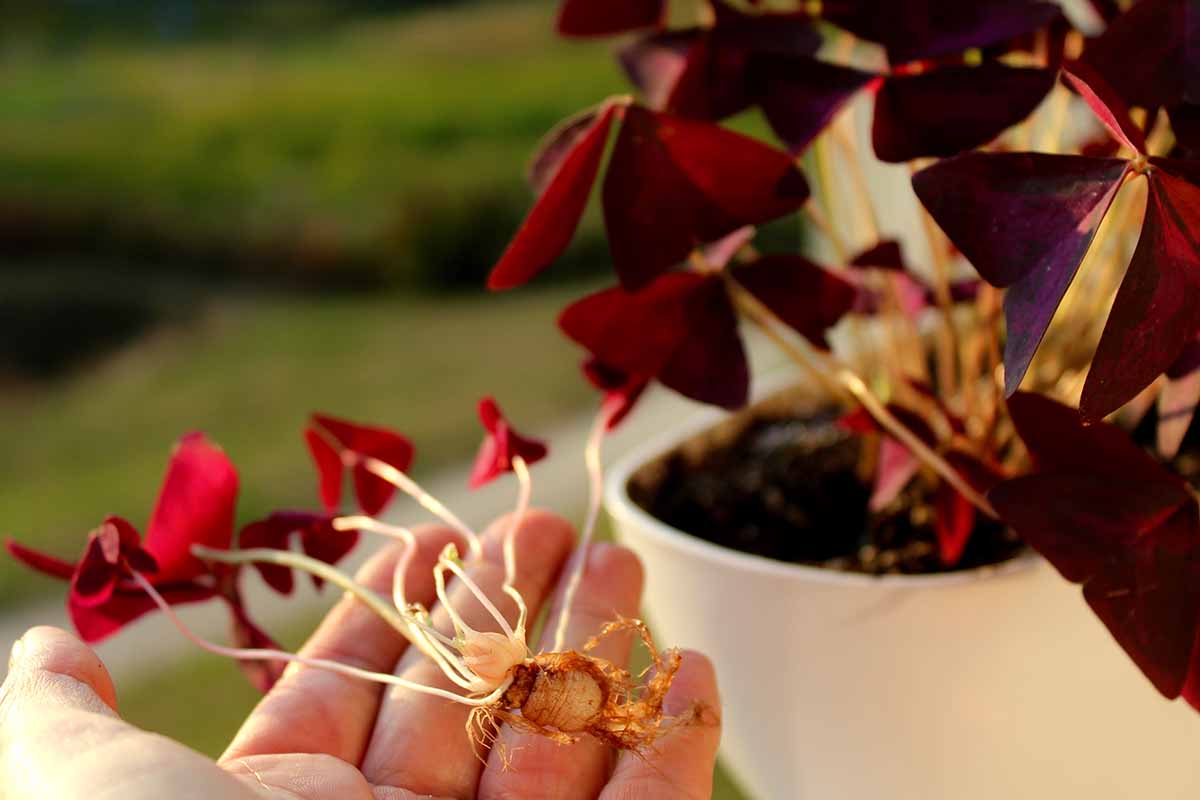
Choose a well-draining, porous container with a diameter of six inches, and fill it with potting soil. The soil surface should be one inch below the pot rim for easy watering. Add soil slightly higher to allow for some settling.
Unpot the plant and gently remove enough soil to see the tubers. Choose a tuber about an inch in diameter. It must have roots and stems attached. Gently tease the tuber away from the others.
Set the tuber in the center of the pot at a shallow depth of one inch and cover it with soil. Planting too deeply may make Oxalis prone to rotting. Backfill and water. Tamp the soil.
Place the pot three feet from a sunny window for bright, indirect sunlight exposure.
Transplanting
To transplant the contents of a nursery pot to a decorative one, first take note of how deeply the plant sits in its current container.
Select a well-draining pot two inches wider than the outer edge of the foliage. Fill it a quarter to a third full with potting soil.
Unpot the contents of the old container. Loosen the soil at the bottom. If the roots are tightly wound or rootbound, use pruners to cut up into the bottom inch of the roots to sever and loosen them.
Remove as much soil as possible from the tubers if the plant is rootbound. The soil is likely depleted and in need of replacement. If it is not rootbound, you may keep the soil intact around the tubers.
Nestle the plant in the new pot slightly higher than it was in the original container to allow for some settlement. Backfill, tamp the soil, and water.
Set the pot three feet from a sunny window.
Now let’s talk about care after propagation.
How to Grow
An indoor shamrock needs bright, indirect sunlight.
If you keep it on a sunny south-facing windowsill, you may want to move it about three feet away from the glass on hot, bright days to avoid dehydration, leaf scorch, and stress-induced dormancy.
The ideal temperature is 70 to 75°F during the day and 50 to 60°F at night. If the temperature exceeds 80°F, heat stress may cause wilting and premature dormancy.
Use moisture-retentive, organically-rich potting soil. Most potted foliage thrives best in soil with a pH between 4.0 and 6.5. Most packaged potting soil meets this qualification.
Choose a porous pot such as unglazed clay that quickly evaporates excess moisture. Make sure it has one or more drainage holes.
Water when the surface of the soil feels dry. It’s best not to let the pot completely dry out, as not all species can tolerate a dry period.
Fertilize at least once a month during the growing season, from fall through spring. When plants are in bloom, feeding every two to three weeks is best. Use a liquid houseplant fertilizer diluted with water to half strength.
With the onset of summer, a shamrock naturally enters dormancy. Sometimes a random stressful event, like forgetting to water or a drastic temperature change, may also trigger the decline.
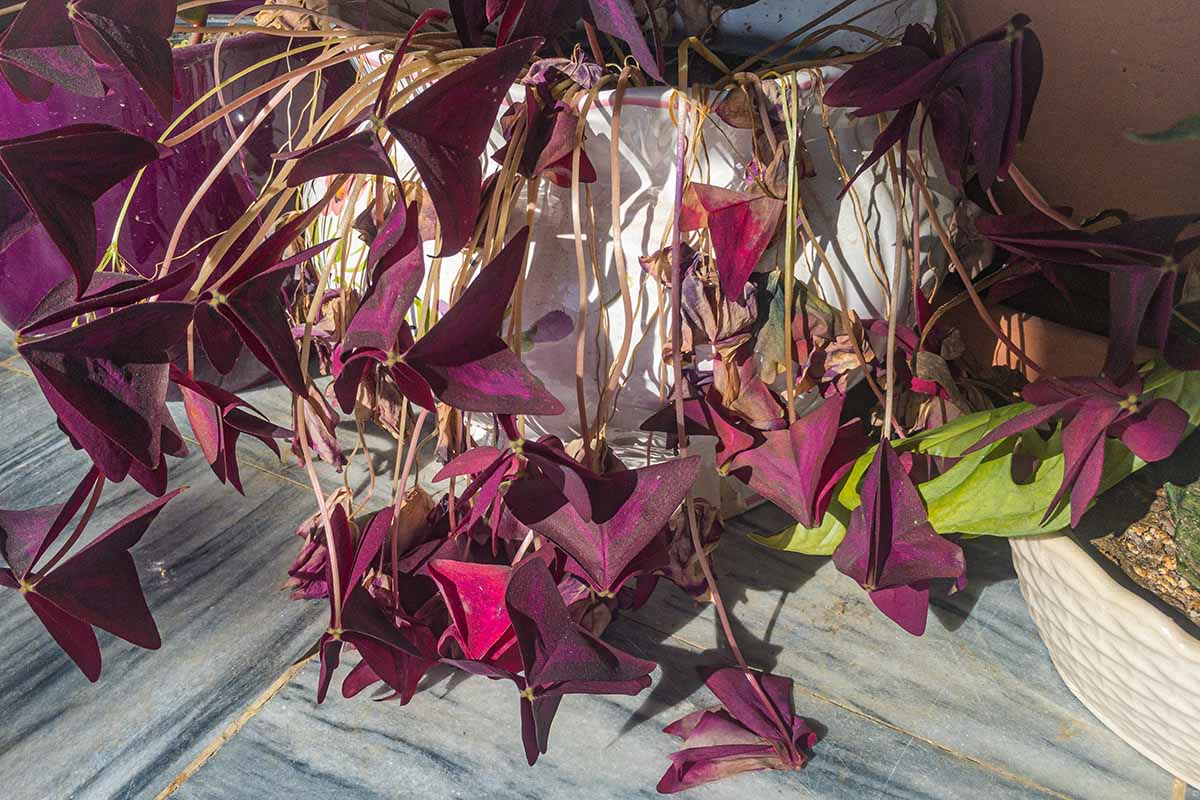
Don’t panic if you wake up one morning and the stems are limp. If the soil is appropriately moist, neither under- nor oversaturated, you can assume that dormancy is underway.
Discontinue watering and fertilizing. As dormancy progresses, the foliage will turn yellow and brown before falling off. Remove the dead foliage.
Move the pot out of the sun and into your home’s coolest, driest location. Let it remain in this spot during dormancy.
A period of one month is usually adequate for purple-leaf varieties, but those with green foliage benefit from a two- to three-month dormancy. You’ll know when dormancy is over because new shoots will appear.
After resting, return the pot to its sunny location and resume watering and fertilizing.
Even if dormancy is stress induced, follow the steps above to allow a rest period before sprouting again.
Growing Tips
When you remember the following, you’re well on your way to successful Oxalis cultivation:
- Select a porous, well-draining pot.
- Use moisture-retentive, organically-rich potting soil.
- Provide a location with bright, indirect sunlight
- Water when the surface of the soil feels dry. Avoid both under- and oversaturation.
- Fertilize with a diluted liquid product each month during the growing season, and more often when plants are in bloom.
- Summer wilting typically signals dormancy, not death.
Now let’s look at some additional care tasks.
Maintenance
To keep your shamrock in tip-top o’ the morning shape, there are a few additional tasks to undertake.
The first is repotting as needed.
Oxalis does best in a snug-fitting pot that limits root growth and promotes optimal foliage production. Expect mature dimensions of six to 18 inches tall and 12 to 24 inches wide.
The time to move up to a larger pot is when you can no longer comfortably get the watering can spout between the stems and the pot rim. Increase the container size by no more than two inches in diameter to maintain a snug fit.
Be sure to choose a porous pot with at least one drainage hole. Note how deep your plant sits in its old pot. You’ll want to replicate the depth in the new container.
As you unpot, you’ll find that the roots are shallow. Gently remove most of the old soil from around them. Try not to separate the tubers to preserve a uniform mound of foliage.
Fill the new container two-thirds of the way with potting soil.
Settle the crown, where the shoots emerge from the tubers, slightly higher than before. I like to do this because good quality potting soil is light and airy and usually settles a little lower after watering.
Backfill with soil and tamp it down.
Water well. The tubers should now be approximately two inches from the top of the pot rim and one inch below the soil.
Autumn, when the new shoots appear, is the perfect time to divide the tubers as described in the propagation section above. It’s a great way to reduce bulk and have more plants to keep or share.
When planting multiple individual tubers in the same pot, allow about three inches between them to facilitate airflow and nutrient uptake.
After flowering, remove the spent flower stalks to maintain a tidy appearance.
And finally, remove dead or damaged foliage during the growing season. It improves the overall appearance and lowers susceptibility to pests and disease.
Species, Varieties, and Cultivars to Select
There are numerous Oxalis species, variations, and cultivated varieties from which to choose, including:
Green Shamrock
Green Shamrock (O. regnellii) has bright green leaves that vary from triangular to heart-shaped.

The foliage resembles the lush fields of Ireland, and a flurry of bright white blossoms hovers like a puffy cloud.
Green shamrock is available from Easy to Grow Store via Amazon in packages of 20 tubers.
A cultivated variety you may like is O. regnellii ‘Irish Mist.’ It has variegated white and green leaves.
Lucky Clover
Lucky clover, aka lucky shamrock, O. tetraphylla (syn. O. deppei) ‘Iron Cross,’ has four-lobed green leaves accented by purple.

The four-leaf variegated, heart-like foliage and bold pink blossoms make an eye-catching addition to home or office decor.
Lucky clover is available from C Z Grain via Amazon in packages of 20 tubers.
Purple Shamrock
Purple, or false shamrock, O. triangularis (aka O. regnellii var. triangularis), has deep plum-colored foliage with purple center streaks.

Pink blossoms perch sweetly above the bold foliage below.
Purple shamrock is available from C Z Grain via Amazon in packages of 10 tubers.
A cultivar you may also find attractive is ‘Mijke.’ Instead of two-tone purple foliage, the leaves are solid purple.
Managing Pests and Disease
Oxalis species are not prone to pests or disease, especially when grown indoors. However, under less-than-ideal conditions, they may become vulnerable.
Examples are a room that is hotter or colder than recommended, soil that is too dry or wet, and too much or too little sunlight.
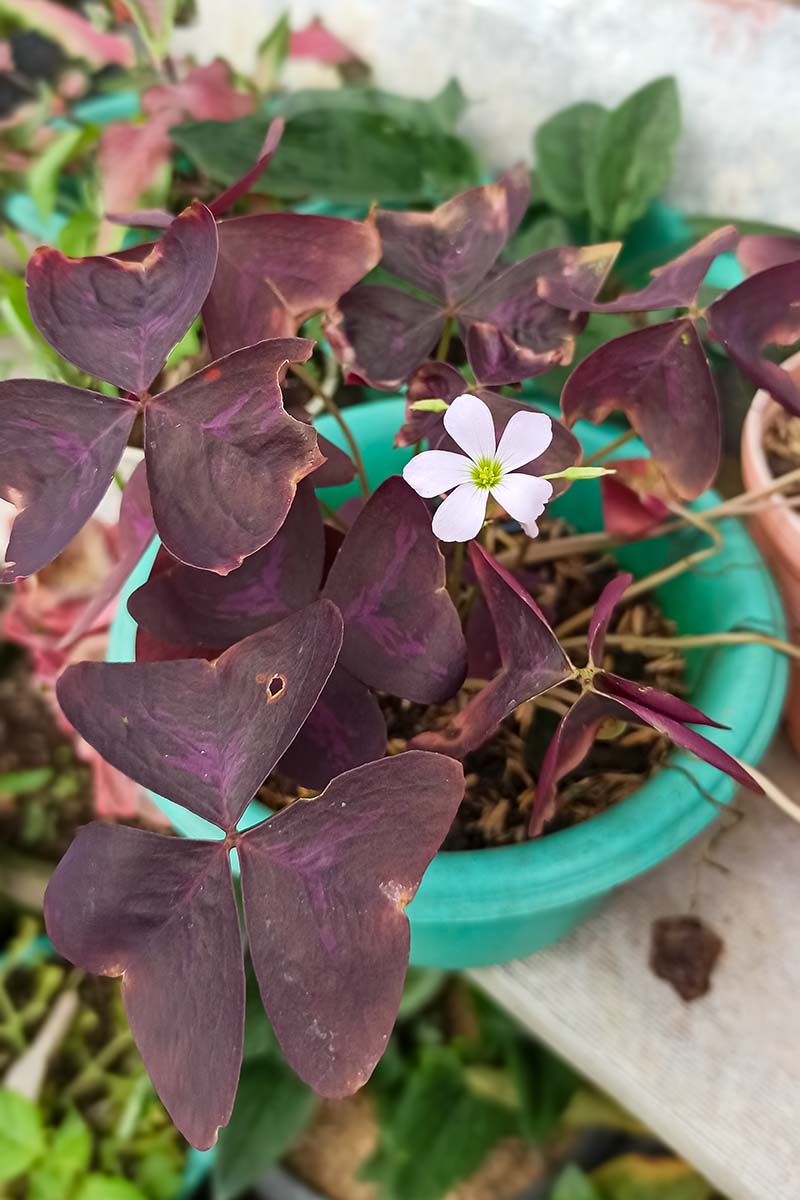
Some common houseplant pests you may encounter are:
Pests may be vectors or carriers of disease.
Potential diseases and the pathogens that cause them include:
- Beet Curly Top Virus, a curtovirus transmitted by the beet leafhopper, Circulifer tenellus
- Powdery Mildew, Microsphaera russellii
- Rust, Puccinia sorghi
- Smut Fungus, Ustilago oxalidis
Outdoor plants that are overly wet or grown near corn or beets are far more likely to suffer from these diseases than houseplants.
Read more about these potential pests and diseases in the referenced guides.
Quick Reference Growing Guide
| Plant Type: | Herbaceous perennial | Flower/Foliage Color: | Pink, red, white, yellow/green, purple, variegated |
| Native to: | Africa; North, South, and Central America; French Polynesia | Water Needs: | Moderate |
| Hardiness (USDA Zone): | 8-11 (outdoors) | Maintenance: | Low |
| Bloom Time: | Spring to summer | Soil Type: | Organically-rich, moisture-retentive potting soil (indoors), sandy loam (outdoors) |
| Exposure: | Bright, indirect sunlight (indoors), full sun to part shade (outdoors) | Soil pH: | 4.0-6.5 |
| Spacing: | 12-24 inches | Soil Drainage: | Well-draining |
| Planting Depth: | 1 inch (tubers), same depth as original container (transplants) | Order: | Oxalidales |
| Height: | 6-18 inches | Family: | Oxalidaceae |
| Spread: | 12-24 inches | Genus: | Oxalis |
| Common Pests and Diseases: | Aphids, spider mites, thrips, whiteflies; beet curly top virus, powdery mildew, rust, smut fungus | Species: | Regnellii, triangularis, tetraphylla |
Irish Eyes Are Smilin’
Even though it’s not clover or Irish, I like Oxalis shamrocks because they are showy, easy to care for, and long-lived.

Knowing that their summer slump is not the end but a period of dormancy from which they reawaken is probably not as widely advertised by nurseries as it should be.
But now you know this secret and how to propagate even more plants by dividing the tubers.
My Irish eyes still smile when I see a shamrock, and I hope yours will, too.
Do you grow shamrock plants at home? We’d love to hear about it in the comments section below.
If you enjoyed reading this guide and want to learn about more houseplants with nyctanistic behaviors, like nighttime flower and leaf closing, we recommend the following next:



I just repotted my green shamrock plant! I didn’t realize that I should keep the flowers on. So I planted them without the green..the only thing is, I hope I didn’t put them, the rizomes upside down!
It’s been two weeks since I transplanted them! They did not come up yet!
Hi Ellie –
If you did plant them upside down, it will just take the shoots longer to make their way to the soil surface. They should emerge within one month.
I LOVE my wonderful green shamrock plant. My husband brought him home about 10 years ago, bought at a whole foods outside plant area, as a St. Patricks Day gift. It Blooms every St. Patty’s Day and once I found the exact area he loved the best (filtered sunlight), he has been thriving. I repot him about every two years and he’s grown about 5 times his original size. I love that guy! And I think he loves us too!
Hi Mary –
That’s wonderful! Thank you for sharing and Happy St. Patrick’s Day!
Our largest pot of green shamrocks will be 5 years years old on St Patrick’s Day. We live in zone 9 and the pot remains outside year round. It resides under the shade (west side) of an ancient live grand oak. The pot is a 12” clay pot.
Hello Walter –
A shamrock can grow quite nicely outdoors in Zones 8 to 11 with full sun to part shade. It sounds like yours is in the perfect spot. Thanks for sharing and Happy St. Patrick’s Day!